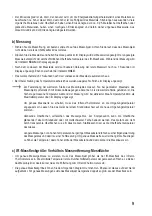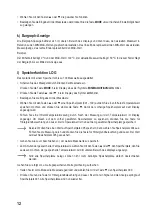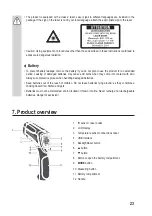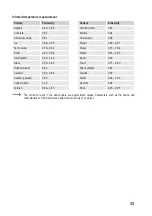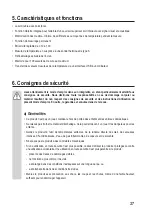
22
• Always observe the safety and operating instructions of any other devices which are connected to the
product.
• During outdoor use, the appliance must only be operated when the weather conditions are suitable and
only with the appropriate safety devices.
• Moisture, dust, fume and/or vapours can affect the optics of the thermometer and thus the measured
results.
• Do not use the thermometer immediately after it has been brought from a cold environment into a
warm room. The resulting condensation may destroy the interior components. In addition, the lens may
become misty, which can lead to inaccurate measurements. Wait until the thermometer has reached the
ambient temperature before using it.
• Always comply with the accident prevention regulations for electrical equipment when using the product
in commercial facilities.
• Trained personnel must supervise the use of electrical appliances in schools, training facilities and DIY
workshops.
• Consult a technician if you are not sure how to use or connect the product.
• Maintenance, modifications and repairs must be done by a technician or a specialist repair centre.
• If you have questions which remain unanswered by these operating instructions, contact our technical
support service or other technical personnel.
b) Laser
• When operating the laser equipment, always make sure that the laser beam is directed so that no one
is in the projection area and that unintentionally reflected beams (e.g. from reflective objects) cannot be
directed into areas where people are present.
• Laser radiation can be dangerous, if the laser beam or its reflection enters unprotected eyes. Before
using the thermometer, familiarise yourself with the statutory regulations and instructions for operating
such a laser device.
• Never look into the laser beam and never point it at people or animals. Laser radiation can seriously
damage your eyes.
• If laser radiation enters your eyes, close your eyes immediately and move your head away from the
beam.
• If your eyes have been irritated by laser radiation, do not continue to carry out tasks with safety
implications, such as working with machines, working from great heights or close to high voltage. Do not
drive any vehicles until the irritation has completely subsided.
• Do not point the laser beam at mirrors or other reflective surfaces. The uncontrolled, reflected beam may
strike people or animals.
• Never open the device. Configuration or maintenance tasks must only be completed by a trained
specialist who is familiar with the potential hazards. Improperly executed adjustments might result in
dangerous laser radiation.


